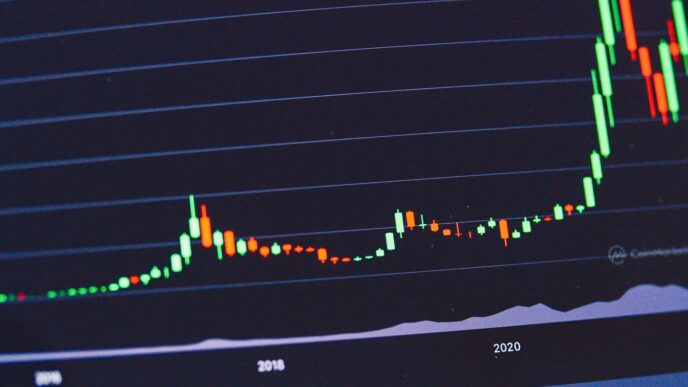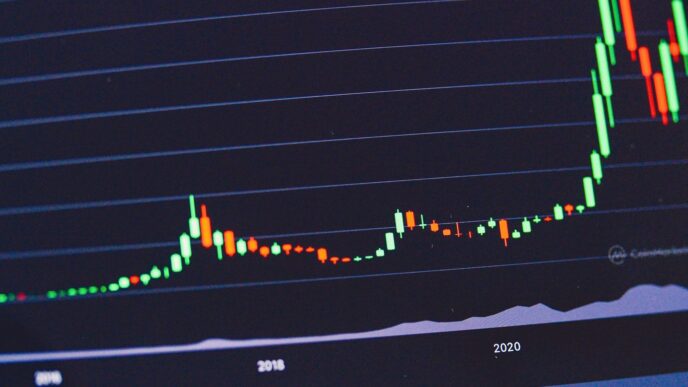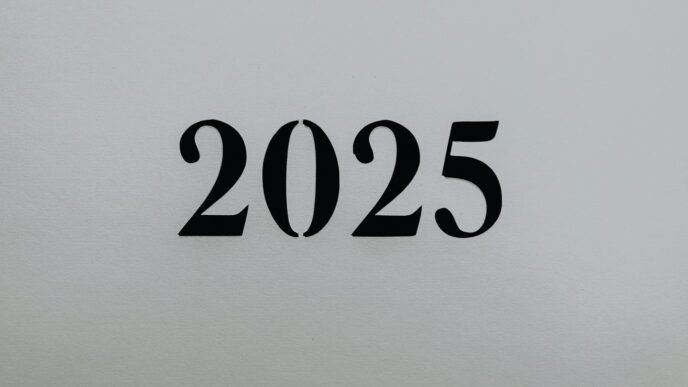So, you wanna know what the CoinDesk 20 is all about? You’re in the right spot! This guide breaks down everything important about the coindesk 20, from what it is to how it can help you understand the crypto market. We’ll look at how it’s put together, what it means for market trends, and even how people use it for their investments. Basically, we’re making sense of this big crypto index so you can get a better handle on things. It’s not as complicated as it sounds, promise!
Key Takeaways
- The CoinDesk 20 is a list of top digital assets, picked using a clear set of rules.
- You can use the CoinDesk 20 to spot market trends and see what’s happening with crypto prices.
- It helps people spread out their investments and manage risk in the crypto world.
- The CoinDesk 20 affects how people feel about the market and helps measure how well crypto is doing.
- This index also shows new ideas in blockchain and how regulations might change things.
Understanding the CoinDesk 20 Index
Defining the CoinDesk 20
Okay, so what is the CoinDesk 20? Basically, it’s an index designed to measure the performance of the top digital assets. Think of it like the S&P 500, but for crypto. It gives you a snapshot of how the overall crypto market is doing by tracking the performance of the 20 largest and most liquid digital assets. It’s not just about market cap, though; there are other factors involved, which we’ll get into.
Methodology Behind the Selection
So, how do they pick which cryptos make the cut? It’s not just a popularity contest. Here’s a breakdown:
- Market Capitalization: This is a big one. They look at the size of each crypto to make sure it’s substantial enough to be included.
- Liquidity: How easily can you buy and sell the asset without affecting the price too much? High liquidity is key.
- Eligibility Criteria: There are some rules about what can’t be included. For example, CoinDesk Indices prioritizes security, so assets involved in proven scams or illegal activities are out.
- Review Process: The CoinDesk Indices team regularly reviews the composition of the index and makes adjustments as needed. This ensures the index remains relevant and representative of the market.
Key Criteria for Inclusion
Let’s drill down a bit more on those key criteria. It’s not just about being big; it’s about being solid. Here’s what they look for:
- Sustained Market Presence: They want to see that a crypto has been around for a while and isn’t just a flash in the pan.
- Regulatory Compliance: Cryptos that are actively working to comply with regulations are viewed more favorably.
- Community Support: A strong and active community can be a good indicator of a project’s long-term viability. Think about coins like DOGE, which has a huge community. Even with the uncertainty in the SEC regulatory landscape, it’s still one to watch.
- Technological Innovation: Is the project doing something new and interesting? Are they pushing the boundaries of what’s possible with blockchain technology? These things matter. You can stay up to date with the latest news by listening to Markets Daily Crypto Roundup from CoinDesk.
Navigating Market Trends with CoinDesk 20
It’s easy to get lost in the day-to-day chaos of the crypto market. The CoinDesk 20 can be a really helpful tool for making sense of it all. It gives you a broader view, so you’re not just reacting to every little price swing.
Analyzing Price Movements
Looking at how the CoinDesk 20 moves can tell you a lot about the overall health of the crypto market. If the index is consistently going up, it suggests a general bullish trend. If it’s dropping, well, that might signal a bear market. It’s not always that simple, of course, but it’s a good starting point. For example, the CoinDesk 20 index rose recently, indicating positive market movement.
Identifying Emerging Patterns
Beyond just up or down, the CoinDesk 20 can help you spot patterns. Are certain types of cryptocurrencies (like DeFi tokens or layer-2 solutions) consistently outperforming others? This could point to new trends that are worth looking into. Keep an eye on which assets are driving the index’s performance; it’s often a sign of what’s hot. Here’s a simple way to track performance:
- Daily Changes: Track the daily percentage change of each asset.
- Weekly Summaries: Compile weekly reports highlighting top gainers and losers.
- Monthly Reviews: Conduct monthly reviews to identify longer-term trends.
Leveraging Index Data for Insights
The CoinDesk 20 isn’t just a number; it’s a source of data. You can use it to compare the performance of individual cryptocurrencies against the broader market. If a coin in your portfolio isn’t keeping up with the index, it might be time to rethink your strategy. Also, pay attention to the weighting of each asset in the index. Changes in weighting can reflect shifts in market capitalization and investor interest. You can find more information on crypto outlets that provide analysis and insights into these trends. Plus, consider these points:
- Compare Individual Assets: See how your holdings stack up against the index components.
- Monitor Weighting Changes: Understand how market dynamics affect asset distribution.
- Use Historical Data: Analyze past performance to predict future trends.
Investment Strategies and the CoinDesk 20
Okay, so you’re looking at the CoinDesk 20 and thinking, "How can I actually use this thing to make some smart investment decisions?" It’s not just about watching the numbers go up and down; it’s about understanding how to incorporate the index into your overall strategy. Let’s break down some ways to approach it.
Portfolio Diversification with the Index
Diversification is key in any investment strategy, and crypto is no different. The CoinDesk 20 can be a tool to diversify your crypto holdings without having to pick individual winners (or losers). Instead of trying to guess which altcoin will moon next, you get exposure to a basket of the top digital assets. Think of it like a mutual fund, but for crypto.
Here’s a simple way to think about it:
- Reduce Risk: Spreading your investment across multiple assets can cushion the blow if one asset tanks. Remember when NEAR Protocol and Polkadot took a hit? Diversification helps.
- Capture Broad Market Growth: You’re not just betting on one horse; you’re betting on the whole race. If the crypto market as a whole does well, your portfolio benefits.
- Simplify Portfolio Management: Instead of constantly rebalancing a portfolio of dozens of coins, you can focus on the CoinDesk 20 and make adjustments as the index changes.
Risk Management Approaches
Crypto is volatile, no surprise there. Managing risk is super important. The CoinDesk 20 can help, but it’s not a magic bullet. Here are some things to keep in mind:
- Stop-Loss Orders: Set up stop-loss orders to automatically sell if an asset falls below a certain price. This can help limit your losses during a market downturn.
- Position Sizing: Don’t put all your eggs in one basket. Determine how much of your portfolio you’re comfortable allocating to crypto, and then size your positions accordingly. Maybe start small and add more as you get more comfortable.
- Regular Rebalancing: The CoinDesk 20 is rebalanced periodically. You should rebalance your own portfolio to match the index’s weighting. This ensures you’re not overexposed to any one asset.
Long-Term Investment Perspectives
Thinking long-term in crypto can be tough, but it’s often the best approach. The CoinDesk 20 can be a good way to gain exposure to the digital assets that are likely to stick around. It’s not about getting rich quick; it’s about building wealth over time.
- Dollar-Cost Averaging: Invest a fixed amount of money at regular intervals, regardless of the price. This helps smooth out the volatility and can lead to better returns over the long run.
- Focus on Fundamentals: Pay attention to the underlying technology and adoption of the assets in the CoinDesk 20. Are they solving real-world problems? Are they gaining traction with users?
- Stay Informed: Keep up with the latest news and developments in the crypto space. The regulatory landscape is constantly changing, and it’s important to stay ahead of the curve. Remember how the SEC keeps things muddy? Staying informed is key.
The Impact of CoinDesk 20 on Crypto Markets
The CoinDesk 20 index isn’t just a list; it’s a force that shapes how people see and interact with the crypto market. It’s like a yardstick, a benchmark, and sometimes, even a self-fulfilling prophecy. It’s interesting how much influence a single index can have.
Influence on Investor Sentiment
The CoinDesk 20 can really sway how investors feel. If the index is doing well, people get excited and want to buy in. If it’s down, there’s often a wave of worry. It’s a bit like a popularity contest for cryptocurrencies. The index’s performance can either boost confidence or trigger fear, which then drives buying or selling. It’s a cycle.
Driving Market Liquidity
When a cryptocurrency is included in the CoinDesk 20, it usually sees a boost in trading volume. More people are watching it, and more funds might be allocated to it. This increased activity makes it easier to buy and sell without drastically affecting the price, which is what we mean by liquidity. Think of it like this: a popular stock is easier to trade than one nobody’s heard of. For example, you can check out CoinDesk’s analysis of market trends.
Benchmarking Performance Against the Index
Traders and fund managers often use the CoinDesk 20 as a benchmark. They compare their own crypto portfolios to the index to see how well they’re doing. If a portfolio is outperforming the index, that’s generally seen as good. If it’s underperforming, it might be time to rethink the strategy. It’s a way to measure success in the crypto world. It’s like grading your homework against an answer key.
Exploring Digital Assets Within CoinDesk 20

Alright, let’s get into the nitty-gritty of what makes up the CoinDesk 20. It’s not just about throwing a bunch of cryptos together; it’s about understanding what each asset brings to the table. We’re talking about the big players, the ones that move markets and shape the future of digital finance. So, buckle up; we’re going asset-by-asset.
Deep Dive into Constituent Cryptocurrencies
Each cryptocurrency in the CoinDesk 20 has its own story, its own tech, and its own community. Understanding these individual characteristics is key to grasping the index’s overall behavior. It’s like knowing the players on a sports team – you can’t predict the game without knowing their strengths and weaknesses. For example, Bitcoin is the OG, the one that started it all. Ethereum is the platform for decentralized apps. And then you have all the others, each with its own unique selling point. It’s a diverse bunch, and that’s what makes it interesting.
Understanding Asset Weighting
Not all cryptocurrencies are created equal, and the CoinDesk 20 reflects that. The weighting of each asset determines its influence on the index’s overall performance. Think of it like this: if Bitcoin sneezes, the whole market catches a cold. But if some smaller altcoin hiccups, it might not even register. The weighting methodology aims to balance representation with market impact. It’s not a perfect science, but it’s designed to give a fair picture of the market’s health. You can find more information about the CoinDesk Digital Assets Quarterly Report online.
Future Outlook for Included Assets
What’s next for the cryptocurrencies in the CoinDesk 20? That’s the million-dollar question, isn’t it? The future is uncertain, but we can make some educated guesses based on current trends and developments. Here are a few things to keep an eye on:
- Technological advancements: Are there any major upgrades or new features on the horizon? These can significantly impact an asset’s value.
- Regulatory changes: Governments around the world are still figuring out how to regulate crypto. New laws could be a game-changer.
- Market adoption: Is the asset gaining traction with mainstream users and institutions? Increased adoption usually leads to higher prices.
It’s a wild ride, but that’s what makes it exciting. Keep learning, stay informed, and you’ll be well-equipped to navigate the ever-changing world of digital assets.
Beyond the Numbers: CoinDesk 20 and Innovation
Spotlighting Blockchain Advancements
The CoinDesk 20 isn’t just about tracking prices; it’s a window into the evolution of blockchain technology. The index includes assets that represent different facets of blockchain innovation, from layer-2 scaling solutions to new consensus mechanisms. It’s interesting to see how these projects perform over time, as it gives you a sense of what areas of blockchain are gaining traction. For example, if you see a lot of activity in London blockchain industry conference, it might be a sign that regulation is becoming more favorable for blockchain businesses.
Tracking Decentralized Finance Growth
DeFi is a huge part of the crypto space, and the CoinDesk 20 reflects that. Many of the assets included are integral to various DeFi protocols, whether it’s providing liquidity, enabling lending, or governing decentralized organizations. Keeping an eye on these assets can give you a good idea of the overall health and direction of the DeFi market. Here are some key DeFi trends to watch:
- Growth of decentralized exchanges (DEXs)
- Adoption of yield farming and staking platforms
- Development of new DeFi lending protocols
The Role of Regulation in Index Evolution
Regulation is a big deal for crypto, and it definitely impacts the CoinDesk 20. Changes in regulations can affect the price and adoption of different digital assets, which in turn can influence their weighting in the index. It’s important to stay informed about regulatory developments and how they might impact the crypto market. For example, if a country bans a certain cryptocurrency, it could have a negative impact on its price and its representation in the index. Here’s a quick look at how regulation can affect the index:
- Increased regulation can lead to greater institutional adoption.
- Uncertainty around regulation can create market volatility.
- Clear regulatory frameworks can foster innovation and growth.
Resources for CoinDesk 20 Enthusiasts
Official CoinDesk Publications
CoinDesk is a pretty big name in crypto news, and they’ve got a bunch of ways to keep up with what’s happening. They have articles, videos, podcasts, and newsletters. It’s a lot to take in, but it’s all there if you want it. CoinDesk is a leading crypto news outlet [#072a].
Expert Analysis and Commentary
It can be hard to know who to trust in the crypto world. There are a lot of opinions out there, and not all of them are good. Finding reliable analysis is key. Some places to look include:
- Blockworks: They do news with insights, webinars, and DeFi research tools.
- Coin Bureau: This is more of an educational hub with videos and explainers.
- The Defiant: They focus on DeFi with interviews and protocol breakdowns.
Community Forums and Discussions
Sometimes, the best information comes from other people who are also into crypto. Online communities can be super helpful for getting different perspectives and staying up-to-date. Here are a few places to check out:
- Reddit: Subreddits like r/Bitcoin and r/Ethereum are pretty active.
- X / Twitter: You can find real-time commentary and breaking news from people in the crypto space.
- The Crypto Rundown: This podcast breaks down trading activity, trends, and developments in the crypto markets.
Wrapping It Up
So, there you have it. The CoinDesk 20 isn’t just some random list; it’s a pretty good snapshot of what’s happening in the crypto world. Knowing how it works and what it includes can really help you understand the market better. Whether you’re just starting out or you’ve been around crypto for a while, keeping an eye on this index can give you some useful ideas. It’s all about staying informed, right? And this index is a solid tool for that.
Frequently Asked Questions
What exactly is the CoinDesk 20?
The CoinDesk 20 is like a special list of the top 20 cryptocurrencies, picked by CoinDesk. It helps people see how the crypto market is doing overall.
How does CoinDesk decide which cryptocurrencies make the list?
CoinDesk uses clear rules to pick the coins for the CoinDesk 20. They look at things like how big the coin is, how much it’s traded, and if it’s easy to buy and sell. This makes sure only the most important and stable coins are on the list.
Why should I care about the CoinDesk 20?
Watching the CoinDesk 20 can help you understand what’s happening in the crypto world. If the index goes up, it means many top coins are doing well. If it goes down, it might mean the market is struggling. It’s a quick way to check the market’s health.
Can the CoinDesk 20 help me with my crypto investments?
Yes, many people use the CoinDesk 20 to help them invest. It can show you which types of coins are popular or if it’s a good time to buy or sell. But remember, all investments have risks.
How often does the CoinDesk 20 change?
The CoinDesk 20 is updated regularly to make sure it always shows the most important cryptocurrencies. This means coins can be added or removed based on how well they are doing and if they still meet CoinDesk’s rules.
Where can I find more information about the CoinDesk 20?
You can find a lot of information about the CoinDesk 20 on the CoinDesk website. They have articles, charts, and news that explain everything about the index and the coins in it.














